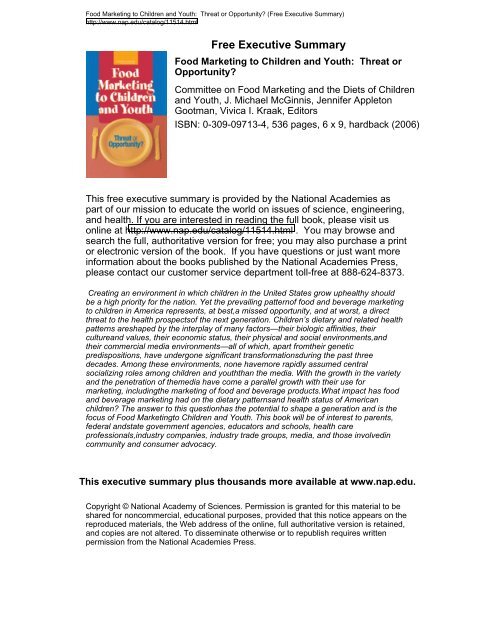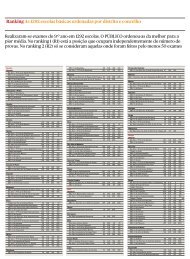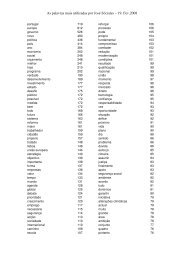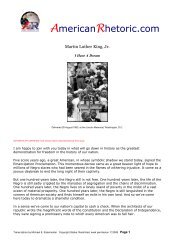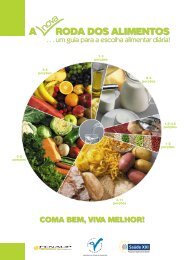Food marketing to children and youth
Food marketing to children and youth
Food marketing to children and youth
Create successful ePaper yourself
Turn your PDF publications into a flip-book with our unique Google optimized e-Paper software.
<strong>Food</strong> Marketing <strong>to</strong> Children <strong>and</strong> Youth: Threat or Opportunity? (Free Executive Summary)http://www.nap.edu/catalog/11514.htmlFree Executive Summary<strong>Food</strong> Marketing <strong>to</strong> Children <strong>and</strong> Youth: Threat orOpportunity?Committee on <strong>Food</strong> Marketing <strong>and</strong> the Diets of Children<strong>and</strong> Youth, J. Michael McGinnis, Jennifer Apple<strong>to</strong>nGootman, Vivica I. Kraak, Edi<strong>to</strong>rsISBN: 0-309-09713-4, 536 pages, 6 x 9, hardback (2006)This free executive summary is provided by the National Academies aspart of our mission <strong>to</strong> educate the world on issues of science, engineering,<strong>and</strong> health. If you are interested in reading the full book, please visit usonline at http://www.nap.edu/catalog/11514.html . You may browse <strong>and</strong>search the full, authoritative version for free; you may also purchase a prin<strong>to</strong>r electronic version of the book. If you have questions or just want moreinformation about the books published by the National Academies Press,please contact our cus<strong>to</strong>mer service department <strong>to</strong>ll-free at 888-624-8373.Creating an environment in which <strong>children</strong> in the United States grow up healthy shouldbe a high priority for the nation. Yet the prevailing pattern of food <strong>and</strong> beverage <strong>marketing</strong><strong>to</strong> <strong>children</strong> in America represents, at best, a missed opportunity, <strong>and</strong> at worst, a directthreat <strong>to</strong> the health prospects of the next generation. Children’s dietary <strong>and</strong> related healthpatterns are shaped by the interplay of many fac<strong>to</strong>rs—their biologic affinities, theirculture <strong>and</strong> values, their economic status, their physical <strong>and</strong> social environments, <strong>and</strong>their commercial media environments—all of which, apart from their geneticpredispositions, have undergone significant transformations during the past threedecades. Among these environments, none have more rapidly assumed centralsocializing roles among <strong>children</strong> <strong>and</strong> <strong>youth</strong> than the media. With the growth in the variety<strong>and</strong> the penetration of the media have come a parallel growth with their use for<strong>marketing</strong>, including the <strong>marketing</strong> of food <strong>and</strong> beverage products. What impact has food<strong>and</strong> beverage <strong>marketing</strong> had on the dietary patterns <strong>and</strong> health status of American<strong>children</strong>? The answer <strong>to</strong> this question has the potential <strong>to</strong> shape a generation <strong>and</strong> is thefocus of <strong>Food</strong> Marketing <strong>to</strong> Children <strong>and</strong> Youth. This book will be of interest <strong>to</strong> parents,federal <strong>and</strong> state government agencies, educa<strong>to</strong>rs <strong>and</strong> schools, health careprofessionals, industry companies, industry trade groups, media, <strong>and</strong> those involved incommunity <strong>and</strong> consumer advocacy.This executive summary plus thous<strong>and</strong>s more available at www.nap.edu.Copyright © National Academy of Sciences. Permission is granted for this material <strong>to</strong> beshared for noncommercial, educational purposes, provided that this notice appears on thereproduced materials, the Web address of the online, full authoritative version is retained,<strong>and</strong> copies are not altered. To disseminate otherwise or <strong>to</strong> republish requires writtenpermission from the National Academies Press.
<strong>Food</strong> Marketing <strong>to</strong> Children <strong>and</strong> Youth: Threat or Opportunity?http://books.nap.edu/catalog/11514.htmlExecutive SummaryCreating an environment in which <strong>children</strong> <strong>and</strong> <strong>youth</strong> can grow up healthyshould be a very high priority for the nation. Yet the prevailing pattern offood <strong>and</strong> beverage <strong>marketing</strong> <strong>to</strong> <strong>children</strong> in America represents, at best, amissed opportunity, <strong>and</strong>, at worst, a direct threat <strong>to</strong> the health of the nextgeneration. Dietary patterns that begin in childhood give shape <strong>to</strong> the healthprofiles of Americans at all ages. Because these patterns reflect the intersectinginfluences of our cultural, social, <strong>and</strong> economic environments, ensuringthat these environments support good health is a fundamental responsibility,requiring leadership <strong>and</strong> action from all sec<strong>to</strong>rs.The dramatic rise in the number of U.S. <strong>children</strong> <strong>and</strong> <strong>youth</strong> who areobese, have type 2 diabetes, <strong>and</strong> are at increased risk for developing obesity<strong>and</strong> related chronic diseases in adulthood, is a matter of national concern.Obesity among <strong>children</strong> <strong>and</strong> <strong>youth</strong> has more than tripled over the past fourdecades—from about 5 percent in 6- <strong>to</strong> 19-year-olds in the 1960s <strong>to</strong> 16 percentin 1999–2002. More than 9 million U.S. <strong>children</strong> <strong>and</strong> <strong>youth</strong> are obese<strong>and</strong> another 15 percent are at risk for becoming obese. The prevalence oftype 2 diabetes among <strong>children</strong> <strong>and</strong> <strong>youth</strong>—previously known as “adul<strong>to</strong>nset”diabetes—has more than doubled in the past decade.As a society, we have moved well beyond the era when our dietaryfocus was on ensuring caloric sufficiency <strong>to</strong> meet basic metabolic needs. Weare now confronted with nutritional inadequacy of a different sort. Dietsthat are high in calories <strong>and</strong> other constituents such as saturated fats, <strong>and</strong>low in certain nutrients are putting our <strong>children</strong> <strong>and</strong> <strong>youth</strong> at risk fordiseases later in life, such as heart disease, stroke, circula<strong>to</strong>ry problems,1Copyright © National Academy of Sciences. All rights reserved.This executive summary plus thous<strong>and</strong>s more available at http://www.nap.edu
<strong>Food</strong> Marketing <strong>to</strong> Children <strong>and</strong> Youth: Threat or Opportunity?http://books.nap.edu/catalog/11514.html2 FOOD MARKETING TO CHILDREN AND YOUTHsome cancers, diabetes, <strong>and</strong> osteoporosis. Parents, communities, the government,public health sec<strong>to</strong>r, health care systems, <strong>and</strong> private enterprise allface significant challenges <strong>to</strong> create an environment for our <strong>children</strong> <strong>and</strong><strong>youth</strong> that turns the course <strong>and</strong> enhances their prospects for healthy lives.DIETARY PATTERNS FOR CHILDREN AND YOUTHHealth-related behaviors such as eating habits <strong>and</strong> physical activitypatterns develop early in life <strong>and</strong> often extend in<strong>to</strong> adulthood. A healthful<strong>and</strong> balanced diet provides recommended amounts of nutrients <strong>and</strong> otherfood components <strong>to</strong> promote normal growth <strong>and</strong> development, reducechronic disease risk, <strong>and</strong> foster appropriate energy balance <strong>and</strong> a healthyweight trajec<strong>to</strong>ry. Yet the diets of America’s <strong>children</strong> <strong>and</strong> adolescents departsubstantially from recommended patterns that puts their health at risk.Although there have been some improvements with respect <strong>to</strong> the intake ofcertain micronutrients, overall our <strong>children</strong> <strong>and</strong> <strong>youth</strong> are not achievingbasic nutritional goals. They are consuming excess calories <strong>and</strong> added sugars<strong>and</strong> have higher than recommended intakes of sodium, <strong>to</strong>tal fat, <strong>and</strong>saturated fats. Moreover, dietary intakes of whole grains, fiber, calcium,potassium, magnesium, <strong>and</strong> vitamin E are well below recommendations<strong>and</strong> are sufficiently low <strong>to</strong> warrant concern. Adolescent girls <strong>and</strong> lowincome<strong>to</strong>ddlers are especially at risk for inadequate intakes of iron.The result is that the health of <strong>children</strong> <strong>and</strong> adolescents is not as goodas it should or could be. Because of improvements in immunization levels,injury rates, <strong>and</strong> the availability of <strong>and</strong> access <strong>to</strong> <strong>children</strong>’s services, death<strong>and</strong> disease rates for <strong>children</strong> are generally low. But more sedentary lifestyles<strong>and</strong> diets that are <strong>to</strong>o high in calories, fat, sugars, <strong>and</strong> sodium, are putting<strong>children</strong>’s futures at risk. Those who are poor face the greatest risk, as aresult of their already greater health, social, <strong>and</strong> nutrition disparities.If <strong>children</strong> <strong>and</strong> <strong>youth</strong> of all income <strong>and</strong> ethnic groups are <strong>to</strong> developdietary patterns that will provide lifelong health promotion <strong>and</strong> diseaseprevention benefits, their diets will need <strong>to</strong> change significantly. Theyneed <strong>to</strong> increase their intakes of fruits, vegetables, legumes, whole grains,<strong>and</strong> low-fat dairy products, <strong>and</strong> reduce their intakes of high-calorie <strong>and</strong>low-nutrient foods <strong>and</strong> beverages, including snack foods <strong>and</strong> sweetenedbeverages.The dietary <strong>and</strong> related health patterns of <strong>children</strong> <strong>and</strong> <strong>youth</strong> resultfrom the interplay of many fac<strong>to</strong>rs (Figure ES-1)—genetics <strong>and</strong> biology,culture <strong>and</strong> values, economic status, physical <strong>and</strong> social environments, <strong>and</strong>commercial <strong>and</strong> media environments—all of which, apart from geneticpredispositions, have undergone significant transformation over the pastthree decades. Among the various environmental influences, none has morerapidly assumed a central socializing role for young people than the media,Copyright © National Academy of Sciences. All rights reserved.This executive summary plus thous<strong>and</strong>s more available at http://www.nap.edu
MarketingProduct, Place,Price, PromotionCulture &ValuesEconomic Fac<strong>to</strong>rsPublic PoliciesProduction,Distribution, PromotionIndividual &DevelopmentalFac<strong>to</strong>rsFamily&HomeSchool&PeersNeighborhood &CommunityGenetics & BiologyDietPhysical ActivityHealthOutcomes forChildren <strong>and</strong> Youth<strong>Food</strong> Marketing <strong>to</strong> Children <strong>and</strong> Youth: Threat or Opportunity?http://books.nap.edu/catalog/11514.html3FIGURE ES-1 Influences on the diets <strong>and</strong> related health outcomes of <strong>children</strong> <strong>and</strong> <strong>youth</strong>.Copyright © National Academy of Sciences. All rights reserved.This executive summary plus thous<strong>and</strong>s more available at http://www.nap.edu
<strong>Food</strong> Marketing <strong>to</strong> Children <strong>and</strong> Youth: Threat or Opportunity?http://books.nap.edu/catalog/11514.html4 FOOD MARKETING TO CHILDREN AND YOUTHin its multiple forms. With its growth in variety <strong>and</strong> penetration has come aconcomitant growth in the promotion of br<strong>and</strong>ed food <strong>and</strong> beverage productsin the marketplace, <strong>and</strong> the influence addressed in this report on thediet <strong>and</strong> related health patterns of <strong>children</strong> <strong>and</strong> <strong>youth</strong>.FOOD AND BEVERAGE MARKETINGThe commercial advertising <strong>and</strong> <strong>marketing</strong> of foods <strong>and</strong> beveragesinfluences the diets <strong>and</strong> health of <strong>children</strong> <strong>and</strong> <strong>youth</strong>. With annual salesnow approaching $900 billion, the food, beverage, <strong>and</strong> restaurant industriestake a central place in the American marketplace. Total <strong>marketing</strong>investments by these industries have not been clearly identified, althoughadvertising alone accounted for more than $11 billion in industry expendituresin 2004, including $5 billion for television advertising. Televisionremains the primary promotional vehicle for measured media <strong>marketing</strong>,but a shift is occurring <strong>to</strong>ward unmeasured sales promotion, such as <strong>marketing</strong>through product placement, character licensing, special events, inschoolactivities, <strong>and</strong> advergames. In fact, only approximately 20 percent ofall food <strong>and</strong> beverage <strong>marketing</strong> in 2004 was devoted <strong>to</strong> advertising ontelevision, radio, print, billboards, or the Internet.Children <strong>and</strong> <strong>youth</strong> represent a primary focus of food <strong>and</strong> beverage<strong>marketing</strong> initiatives. Between 1994 <strong>and</strong> 2004, the rate of increase in theintroduction of new food <strong>and</strong> beverage products targeted <strong>to</strong> <strong>children</strong> <strong>and</strong><strong>youth</strong> substantially outpaced the rate for those targeting the <strong>to</strong>tal market.An estimated more than $10 billion per year is spent for all types of food<strong>and</strong> beverage <strong>marketing</strong> <strong>to</strong> <strong>children</strong> <strong>and</strong> <strong>youth</strong> in America. Moreover, althoughsome very recent public announcements by some in the industrysuggest an interest in change, the preponderance of the products introduced<strong>and</strong> marketed <strong>to</strong> <strong>children</strong> <strong>and</strong> <strong>youth</strong> have been high in <strong>to</strong>tal calories, sugars,salt, <strong>and</strong> fat, <strong>and</strong> low in nutrients.How this <strong>marketing</strong> affects <strong>children</strong> <strong>and</strong> <strong>youth</strong> is the focus of thisreport. The process begins early in life. Children develop consumer socializationskills as they physically <strong>and</strong> cognitively mature. Over the span ofages 2–11 years, they develop consumption motives <strong>and</strong> values as they areexposed <strong>to</strong> commercial activities; they develop knowledge about advertising,products, br<strong>and</strong>s, pricing, <strong>and</strong> shopping; <strong>and</strong> they begin <strong>to</strong> developstrategies for purchase requests <strong>and</strong> negotiation. The family is the firstsocializing agent, as parents <strong>and</strong> older siblings act as sources of information<strong>and</strong> provide social support <strong>and</strong> pressure that affect <strong>children</strong>’s behaviors.Media now have a more central role in socializing <strong>to</strong>day’s <strong>children</strong><strong>and</strong> <strong>youth</strong> than ever before. Advertising <strong>and</strong> <strong>marketing</strong> messages reachyoung consumers through a variety of vehicles—broadcast <strong>and</strong> cable television,radio, magazines, computers through the Internet, music, cellCopyright © National Academy of Sciences. All rights reserved.This executive summary plus thous<strong>and</strong>s more available at http://www.nap.edu
<strong>Food</strong> Marketing <strong>to</strong> Children <strong>and</strong> Youth: Threat or Opportunity?http://books.nap.edu/catalog/11514.htmlEXECUTIVE SUMMARY 5phones—<strong>and</strong> in many different venues—homes, schools, child-care settings,grocery s<strong>to</strong>res, shopping malls, theaters, sporting events, <strong>and</strong> evenairports. Virtually all <strong>children</strong> ages 2–18 years now live in householdswith a television, <strong>and</strong> more than half of <strong>to</strong>day’s <strong>children</strong> <strong>and</strong> <strong>youth</strong> reportthat their families have no rules for television viewing. Children <strong>and</strong> <strong>youth</strong>under the age of 18 years comprise 20 percent of those using the Internet.Myriad <strong>marketing</strong> approaches are now available, <strong>and</strong> targeted <strong>and</strong> integrated<strong>marketing</strong> has become more prevalent.With new outlets, attractions, <strong>and</strong> <strong>to</strong>ols, <strong>children</strong> <strong>and</strong> <strong>youth</strong> represent apowerful demographic force. Collectively, <strong>children</strong> <strong>and</strong> <strong>youth</strong> spend morethan $200 billion annually, <strong>and</strong> they influence many food <strong>and</strong> beveragepurchases beyond those they make directly. Although <strong>children</strong>’s choices arestrongly influenced by their parents <strong>and</strong> siblings, they are increasingly makingdecisions at younger ages in the marketplace, either in ways that areindependent of parental guidance, or as agents influencing the choices <strong>and</strong>purchasing decisions of their parents <strong>and</strong> caregivers. Of the various itemsthat <strong>children</strong> <strong>and</strong> <strong>youth</strong> purchase <strong>and</strong> influence, food <strong>and</strong> beverages—particularly c<strong>and</strong>y, carbonated soft drinks, <strong>and</strong> salty snacks—consistentlyrepresent the leading categories.An important issue in discussions about the influence of food <strong>and</strong>beverage advertising <strong>and</strong> <strong>marketing</strong> reaching <strong>children</strong> <strong>and</strong> <strong>youth</strong> relates <strong>to</strong>the stages of discernment. Before a certain age, <strong>children</strong> lack the defenses,or skills, <strong>to</strong> discriminate commercial from noncommercial content, or <strong>to</strong>attribute persuasive intent <strong>to</strong> advertising. Children generally develop theseskills at about age 8 years, but <strong>children</strong> as old as 11 years may not activatetheir defenses unless explicitly cued <strong>to</strong> do so. Concern about young <strong>children</strong>’slimited ability <strong>to</strong> comprehend the nature <strong>and</strong> purpose of advertising,<strong>and</strong> about the appropriateness or impact of food <strong>marketing</strong> <strong>to</strong> whichyounger <strong>children</strong> might be exposed, led <strong>to</strong> a Federal Trade Commission(FTC) rulemaking process in the late 1970s on the question of whetheradvertising <strong>to</strong> young <strong>children</strong> should be restricted or banned as a protectivemeasure. Congress eventually intervened, <strong>and</strong> the FTC terminated the rulemakingin 1981.The question persists, however, about the effects of advertising exposureon <strong>children</strong>, <strong>and</strong> it has been deepened <strong>and</strong> broadened by a developingappreciation of the influence of environmental signals on personal behaviors,regardless of age; by the expansion <strong>and</strong> the nature of <strong>youth</strong> <strong>and</strong> childorientedfood <strong>and</strong> beverage products in the marketplace; by the dramaticaugmentation of strategic <strong>to</strong>ols <strong>and</strong> vehicles for <strong>marketing</strong> activities; <strong>and</strong>, inparticular, by concern about the relation of the <strong>marketing</strong> environment,among the multiple influences, <strong>to</strong> the rapid growth of childhood obesity inthe United States.This concern is not unique <strong>to</strong> the United States. In addition <strong>to</strong> theCopyright © National Academy of Sciences. All rights reserved.This executive summary plus thous<strong>and</strong>s more available at http://www.nap.edu
<strong>Food</strong> Marketing <strong>to</strong> Children <strong>and</strong> Youth: Threat or Opportunity?http://books.nap.edu/catalog/11514.html6 FOOD MARKETING TO CHILDREN AND YOUTHdiscussions in this country, several related activities have been initiated inother countries <strong>and</strong> through international organizations. Certain countrieshave instituted formal bans or restrictions on televised food <strong>and</strong> beverageadvertising <strong>to</strong> <strong>children</strong>. Others have undertaken reviews of the issue. Prior<strong>to</strong> this study, the most recent systematic evidence review of the scientificliterature was the report of Hastings <strong>and</strong> colleagues in 2003, sponsored bythe <strong>Food</strong> St<strong>and</strong>ards Agency in the United Kingdom. That study found thatfood advertising <strong>to</strong> <strong>children</strong> affected <strong>children</strong>’s preferences, purchase behaviors,<strong>and</strong> consumption, not just for different br<strong>and</strong>s but also for differentfood <strong>and</strong> beverage categories. In 2004, the World Health Assembly,drawing on a number of key documents, endorsed <strong>marketing</strong> practices <strong>and</strong>policies that acknowledged the vulnerability of <strong>children</strong> <strong>and</strong> encouraged<strong>marketing</strong> practices that promote healthful foods <strong>and</strong> beverages. Our reviewhas been undertaken in a context of global interest in the issue.COMMITTEE APPROACH AND EVIDENCE REVIEWThe Committee on <strong>Food</strong> Marketing <strong>and</strong> the Diets of Children <strong>and</strong>Youth was established in 2004. Its charge was <strong>to</strong> explore what is knownabout current food <strong>and</strong> beverage <strong>marketing</strong> practices, the influence of thesepractices on the diets <strong>and</strong> health of U.S. <strong>children</strong> <strong>and</strong> <strong>youth</strong>, <strong>and</strong> public <strong>and</strong>private strategies that have been used or could be used <strong>to</strong> promote healthfulfood <strong>and</strong> beverage choices among <strong>children</strong> <strong>and</strong> <strong>youth</strong>. The committee recognizesthat a variety of interacting fac<strong>to</strong>rs affect the health <strong>and</strong> weight of<strong>children</strong> <strong>and</strong> <strong>youth</strong>, including societal norms, culture, socioeconomic fac<strong>to</strong>rs,race/ethnicity, education, <strong>and</strong> physical activity. Although important,these are not the subject of this report, which specifically examines the roleof food <strong>and</strong> beverage <strong>marketing</strong> in the diets of <strong>children</strong> <strong>and</strong> <strong>youth</strong>.The committee drew on multiple sources of evidence in its review,including peer-reviewed literature, as well as industry <strong>and</strong> <strong>marketing</strong>sources. Particular attention <strong>and</strong> emphasis was given <strong>to</strong> the development<strong>and</strong> implementation of a disciplined process of gathering, classifying, <strong>and</strong>considering the available scientific literature relevant <strong>to</strong> the committee’scharge. Articles identified in an initial search of the literature werescanned for relevance <strong>and</strong> methodologic rigor. Approximately 200 of thestrongest <strong>and</strong> most pertinent articles were further reviewed <strong>and</strong>, of these,123 were subjected <strong>to</strong> a systematic evidence review using a pro<strong>to</strong>col establishedby the committee. Each study was coded on several dimensions,including the relationship of <strong>marketing</strong> <strong>to</strong> diet, the cause <strong>and</strong> effect variablesstudied, the methods used, <strong>and</strong> the comparative relevance of theevidence. The results drawn from this assessment provide much of thefoundation for the recommendations of this report <strong>and</strong> are discussed inChapter 5.Copyright © National Academy of Sciences. All rights reserved.This executive summary plus thous<strong>and</strong>s more available at http://www.nap.edu
<strong>Food</strong> Marketing <strong>to</strong> Children <strong>and</strong> Youth: Threat or Opportunity?http://books.nap.edu/catalog/11514.htmlEXECUTIVE SUMMARY 7It is important <strong>to</strong> underscore several points about the literature. First,the importance of this issue comm<strong>and</strong>s much more study. Although thous<strong>and</strong>sof papers <strong>to</strong>uch on the <strong>to</strong>pic, the number of carefully designed studiesis far <strong>to</strong>o limited for a problem that may so substantially affect the nation’shealth <strong>and</strong> that is so intrinsically complicated. Second, the available peerreviewedliterature focuses predominantly on television advertising, butfood <strong>and</strong> beverage <strong>marketing</strong> extends far beyond television <strong>and</strong> is changingrapidly <strong>to</strong> include integrated <strong>marketing</strong> campaigns that extend <strong>to</strong> new mediaplatforms that target multiple venues simultaneously. Virtually no scientificstudies are available <strong>to</strong> assess these other techniques. Third, the greatbulk of the available research that deals with health outcomes involvesdirect measures only of overall television viewing, not exposure <strong>to</strong> televisionadvertising. Because the overall amount of television viewing is highlycorrelated with the amount of exposure <strong>to</strong> television advertising, this measurementstrategy is informative, but interpretation requires adjusting forother fac<strong>to</strong>rs, such as sedentary behavior, snacking frequency, or the typesof foods consumed. Finally, the committee acknowledges that there arecertain constraints that apply <strong>to</strong> any literature of this sort. It concludes thatalthough publication bias is possible in such research, if it exists it is small<strong>and</strong> would not influence the conclusions of the report.On the matter of characterizing commercial <strong>marketing</strong> practices <strong>and</strong>trends, the committee faced several notable challenges. Substantial proprietarymarket research data were either not publicly accessible, or availableonly for purchase at considerable cost <strong>and</strong> with prohibitive constraints onpublic use of the data. Public use provisions were required because theNational Academies are subject <strong>to</strong> section 15 of the Federal Advisory CommitteeAct of 1997, which requires that the National Academies makeavailable <strong>to</strong> the public all written materials presented <strong>to</strong> an expert committeein order for its recommendations <strong>to</strong> be used by a sponsoring governmentagency. The result was highly limited availability <strong>to</strong> the committee ofpotentially relevant proprietary information that could be considered forthe review.The committee was also asked, if feasible, <strong>to</strong> estimate costs <strong>and</strong> providebenchmarks <strong>to</strong> evaluate progress. Because of the complexity of the issues,the multiplicity of stakeholders, <strong>and</strong> the unavailability of data necessary onwhich <strong>to</strong> establish estimates <strong>and</strong> baselines, the committee lacked the evidence<strong>and</strong> resources <strong>to</strong> address these dimensions with confidence. As notedbelow, it did, however, include in its recommendations the designation of apublic agency responsible for tracking progress, <strong>and</strong> the establishment of amechanism for commercial <strong>marketing</strong> data <strong>to</strong> be made available as a publiclyaccessible resource, so that such estimates <strong>and</strong> benchmarks could bedeveloped <strong>and</strong> tracked in the future.Copyright © National Academy of Sciences. All rights reserved.This executive summary plus thous<strong>and</strong>s more available at http://www.nap.edu
<strong>Food</strong> Marketing <strong>to</strong> Children <strong>and</strong> Youth: Threat or Opportunity?http://books.nap.edu/catalog/11514.html8 FOOD MARKETING TO CHILDREN AND YOUTHKEY FINDINGSThe committee’s review indicates that, among many fac<strong>to</strong>rs, food <strong>and</strong>beverage <strong>marketing</strong> influences the preferences <strong>and</strong> purchase requests of<strong>children</strong>, influences consumption at least in the short term, is a likely contribu<strong>to</strong>r<strong>to</strong> less healthful diets, <strong>and</strong> may contribute <strong>to</strong> negative diet-relatedhealth outcomes <strong>and</strong> risks among <strong>children</strong> <strong>and</strong> <strong>youth</strong>. The literature indicatesrelationships among <strong>marketing</strong>, dietary precursors, diets, diet-relatedhealth, <strong>and</strong>, in particular, adiposity (body fatness).Specifically, the committee’s systematic evidence review found that:With respect <strong>to</strong> dietary precursors, food <strong>and</strong> beverage advertising ontelevision has some influence on the preferences <strong>and</strong> purchase requests of<strong>children</strong> <strong>and</strong> <strong>youth</strong>:• There is strong evidence that television advertising influencesthe food <strong>and</strong> beverage preferences of <strong>children</strong> ages 2–11 years. There isinsufficient evidence about its influence on the preferences of teens ages 12–18 years.• There is strong evidence that television advertising influencesthe food <strong>and</strong> beverage purchase requests of <strong>children</strong> ages 2–11 years. Thereis insufficient evidence about its influence on the purchase requests of teensages 12–18 years.• There is moderate evidence that television advertising influencesthe food <strong>and</strong> beverage beliefs of <strong>children</strong> ages 2–11 years. There isinsufficient evidence about its influence on the beliefs of teens ages 12–18 years.• Given the findings from the systematic evidence review of theinfluence of <strong>marketing</strong> on the precursors of diet, <strong>and</strong> given the evidencefrom content analyses that the preponderance of television food <strong>and</strong> beverageadvertising relevant <strong>to</strong> <strong>children</strong> <strong>and</strong> <strong>youth</strong> promotes high-calorie <strong>and</strong>low-nutrient products, it can be concluded that television advertising influences<strong>children</strong> <strong>to</strong> prefer <strong>and</strong> request high-calorie <strong>and</strong> low-nutrient foods<strong>and</strong> beverages.With respect <strong>to</strong> diets, food <strong>and</strong> beverage advertising on television hassome influence on the dietary intake of <strong>children</strong> <strong>and</strong> <strong>youth</strong>:• There is strong evidence that television advertising influencesthe short-term consumption of <strong>children</strong> ages 2–11 years. There is insufficientevidence about its influence on the short-term consumption of teensages 12–18 years.• There is moderate evidence that television advertising influencesthe usual dietary intake of younger <strong>children</strong> ages 2–5 years <strong>and</strong> weakevidence that it influences the usual dietary intake of older <strong>children</strong> ages 6–Copyright © National Academy of Sciences. All rights reserved.This executive summary plus thous<strong>and</strong>s more available at http://www.nap.edu
<strong>Food</strong> Marketing <strong>to</strong> Children <strong>and</strong> Youth: Threat or Opportunity?http://books.nap.edu/catalog/11514.htmlEXECUTIVE SUMMARY 911 years. There is also weak evidence that it does not influence the usualdietary intake of teens ages 12–18 years.With respect <strong>to</strong> diet-related health, food <strong>and</strong> beverage advertising ontelevision is associated with the adiposity (body fatness) of <strong>children</strong> <strong>and</strong><strong>youth</strong>:• Statistically, there is strong evidence that exposure <strong>to</strong> televisionadvertising is associated with adiposity in <strong>children</strong> ages 2–11 years <strong>and</strong>teens ages 12–18 years.• The association between adiposity <strong>and</strong> exposure <strong>to</strong> televisionadvertising remains after taking alternative explanations in<strong>to</strong> account, butthe research does not convincingly rule out other possible explanations forthe association; therefore, the current evidence is not sufficient <strong>to</strong> arrive atany finding about a causal relationship from television advertising <strong>to</strong> adiposity.It is important <strong>to</strong> note that even a small influence, aggregated overthe entire population of American <strong>children</strong> <strong>and</strong> <strong>youth</strong>, would be consequentialin impact.Most <strong>children</strong> ages 8 years <strong>and</strong> under do not effectively comprehendthe persuasive intent of <strong>marketing</strong> messages, <strong>and</strong> most <strong>children</strong> ages 4 years<strong>and</strong> under cannot consistently discriminate between television advertising<strong>and</strong> programming. The evidence is currently insufficient <strong>to</strong> determinewhether or not this meaningfully alters the ways in which food <strong>and</strong> beverage<strong>marketing</strong> messages influence <strong>children</strong>.CONCLUSIONS AND RECOMMENDATIONSThe prevalence of obesity in <strong>children</strong> <strong>and</strong> <strong>youth</strong> has occurred in parallelwith significant changes in the U.S. media <strong>and</strong> <strong>marketing</strong> environments.This relationship has lead <strong>to</strong> the committee’s primary inquiry about whatthe available data indicate as <strong>to</strong> the influence of food <strong>and</strong> beverage <strong>marketing</strong>on the diets <strong>and</strong> health of American <strong>children</strong> <strong>and</strong> <strong>youth</strong>. This issue wasthe focus of the committee’s systematic evidence review which is describedin Chapter 5 <strong>and</strong> Appendix F.Embedded in relevant sections throughout the text of the report, thecommittee presents findings in these key dimensions: health, diet, <strong>and</strong> eatingpatterns of <strong>children</strong> <strong>and</strong> <strong>youth</strong>; food <strong>and</strong> beverage <strong>marketing</strong> <strong>to</strong> <strong>children</strong><strong>and</strong> <strong>youth</strong>; the influence of food <strong>and</strong> beverage <strong>marketing</strong> on the diets<strong>and</strong> diet-related health of <strong>children</strong> <strong>and</strong> <strong>youth</strong>; <strong>and</strong> the policy environment.These findings are listed again in Chapter 7. Based on these findings, thecommittee has identified five broad conclusions that serve as the basis forits recommendations (Box ES-1).Reflective of the responsibilities of multiple sec<strong>to</strong>rs, the committee’srecommendations address actions related <strong>to</strong> food <strong>and</strong> beverage production,processing, packaging, <strong>and</strong> sales; <strong>marketing</strong> practice st<strong>and</strong>ards; media <strong>and</strong>Copyright © National Academy of Sciences. All rights reserved.This executive summary plus thous<strong>and</strong>s more available at http://www.nap.edu
<strong>Food</strong> Marketing <strong>to</strong> Children <strong>and</strong> Youth: Threat or Opportunity?http://books.nap.edu/catalog/11514.html10 FOOD MARKETING TO CHILDREN AND YOUTHBOX ES-1Broad Conclusions• Along with many other intersecting fac<strong>to</strong>rs, food <strong>and</strong> beverage <strong>marketing</strong> influencesthe diets <strong>and</strong> health prospects of <strong>children</strong> <strong>and</strong> <strong>youth</strong>.• <strong>Food</strong> <strong>and</strong> beverage <strong>marketing</strong> practices geared <strong>to</strong> <strong>children</strong> <strong>and</strong> <strong>youth</strong> are out ofbalance with healthful diets <strong>and</strong> contribute <strong>to</strong> an environment that puts theirhealth at risk.• <strong>Food</strong> <strong>and</strong> beverage companies, restaurants, <strong>and</strong> marketers have underutilizedpotential <strong>to</strong> devote creativity <strong>and</strong> resources <strong>to</strong> develop <strong>and</strong> promote food, beverages,<strong>and</strong> meals that support healthful diets for <strong>children</strong> <strong>and</strong> <strong>youth</strong>.• Achieving healthful diets for <strong>children</strong> <strong>and</strong> <strong>youth</strong> will require sustained, multisec<strong>to</strong>ral,<strong>and</strong> integrated efforts that include industry leadership <strong>and</strong> initiative.• Public policy programs <strong>and</strong> incentives do not currently have the support or authority<strong>to</strong> address many of the current <strong>and</strong> emerging <strong>marketing</strong> practices thatinfluence the diets of <strong>children</strong> <strong>and</strong> <strong>youth</strong>.entertainment initiatives; parents, caregivers, <strong>and</strong> families; school environments;<strong>and</strong> public policy. Recommendations are also offered for researchactivities necessary <strong>to</strong> chart the path of future improvements, <strong>and</strong> the moni<strong>to</strong>ringcapacity <strong>to</strong> track improvements in <strong>marketing</strong> practices <strong>and</strong> theirinfluence on <strong>children</strong>’s <strong>and</strong> <strong>youth</strong>s’ diets <strong>and</strong> health. These recommendationsreflect the current context <strong>and</strong> information in a rapidly changingenvironment, <strong>and</strong> should be implemented <strong>to</strong>gether as a package <strong>to</strong> support<strong>and</strong> complement one another.<strong>Food</strong> <strong>and</strong> Beverage Production <strong>and</strong> PromotionCentral <strong>to</strong> making progress <strong>to</strong>ward more healthful diets for <strong>children</strong><strong>and</strong> <strong>youth</strong> will be carefully designed <strong>and</strong> sustained commitments bythe food, beverage, <strong>and</strong> quick serve restaurant industries <strong>to</strong> promote theavailability, accessibility, affordability, <strong>and</strong> appeal of nutritious foods <strong>and</strong>beverages.Recommendation 1: <strong>Food</strong> <strong>and</strong> beverage companies should use their creativity,resources, <strong>and</strong> full range of <strong>marketing</strong> practices <strong>to</strong> promote <strong>and</strong>support more healthful diets for <strong>children</strong> <strong>and</strong> <strong>youth</strong>.To implement this recommendation, companies should• Shift their product portfolios in a direction that promotes new <strong>and</strong>Copyright © National Academy of Sciences. All rights reserved.This executive summary plus thous<strong>and</strong>s more available at http://www.nap.edu
<strong>Food</strong> Marketing <strong>to</strong> Children <strong>and</strong> Youth: Threat or Opportunity?http://books.nap.edu/catalog/11514.htmlEXECUTIVE SUMMARY 11reformulated child- <strong>and</strong> <strong>youth</strong>-oriented foods <strong>and</strong> beverages that aresubstantially lower in <strong>to</strong>tal calories, lower in fats, salt, <strong>and</strong> added sugars,<strong>and</strong> higher in nutrient content.• Shift their advertising <strong>and</strong> <strong>marketing</strong> emphasis <strong>to</strong> child- <strong>and</strong> <strong>youth</strong>orientedfoods <strong>and</strong> beverages that are substantially lower in <strong>to</strong>tal calories,lower in fats, salt, <strong>and</strong> added sugars, <strong>and</strong> higher in nutrient content(see later recommendations on public policy <strong>and</strong> moni<strong>to</strong>ring).• Work with government, scientific, public health, <strong>and</strong> consumer groups<strong>to</strong> develop <strong>and</strong> implement labels <strong>and</strong> advertising for an empiricallyvalidated industrywide rating system <strong>and</strong> graphic representation that isappealing <strong>to</strong> <strong>children</strong> <strong>and</strong> <strong>youth</strong> <strong>to</strong> convey the nutritional quality offoods <strong>and</strong> beverages marketed <strong>to</strong> them <strong>and</strong> their families.• Engage the full range of their <strong>marketing</strong> vehicles <strong>and</strong> venues <strong>to</strong> develop<strong>and</strong> promote healthier appealing <strong>and</strong> affordable foods <strong>and</strong> beveragesfor <strong>children</strong> <strong>and</strong> <strong>youth</strong>.Recommendation 2: Full serve restaurant chains, family restaurants, <strong>and</strong>quick serve restaurants should use their creativity, resources, <strong>and</strong> fullrange of <strong>marketing</strong> practices <strong>to</strong> promote healthful meals for <strong>children</strong> <strong>and</strong><strong>youth</strong>.To implement this recommendation, restaurants should• Exp<strong>and</strong> <strong>and</strong> actively promote healthier food, beverage, <strong>and</strong> meal optionsfor <strong>children</strong> <strong>and</strong> <strong>youth</strong>.• Provide calorie content <strong>and</strong> other key nutrition information, as possible,on menus <strong>and</strong> packaging that is prominently visible at the poin<strong>to</strong>f choice <strong>and</strong> use.Recommendation 3: <strong>Food</strong>, beverage, restaurant, retail, <strong>and</strong> <strong>marketing</strong> industrytrade associations should assume transforming leadership roles inharnessing industry creativity, resources, <strong>and</strong> <strong>marketing</strong> on behalf ofhealthful diets for <strong>children</strong> <strong>and</strong> <strong>youth</strong>.To implement this recommendation, trade associations should• Encourage member initiatives <strong>and</strong> compliance <strong>to</strong> develop, apply, <strong>and</strong>enforce industry-wide food <strong>and</strong> beverage <strong>marketing</strong> practice st<strong>and</strong>ardsthat support healthful diets for <strong>children</strong> <strong>and</strong> <strong>youth</strong>.• Provide technical assistance, encouragement, <strong>and</strong> support for members’efforts <strong>to</strong> emphasize the development <strong>and</strong> <strong>marketing</strong> of healthier foods,beverages, <strong>and</strong> meals for <strong>children</strong> <strong>and</strong> <strong>youth</strong>.• Exercise leadership in working with their members <strong>to</strong> improve theavailability <strong>and</strong> selection of healthful foods <strong>and</strong> beverages accessible atCopyright © National Academy of Sciences. All rights reserved.This executive summary plus thous<strong>and</strong>s more available at http://www.nap.edu
<strong>Food</strong> Marketing <strong>to</strong> Children <strong>and</strong> Youth: Threat or Opportunity?http://books.nap.edu/catalog/11514.html12 FOOD MARKETING TO CHILDREN AND YOUTHeye level <strong>and</strong> reach for <strong>children</strong>, <strong>youth</strong>, <strong>and</strong> their parents in grocerys<strong>to</strong>res <strong>and</strong> other food retail environments.• Work <strong>to</strong> foster collaboration <strong>and</strong> support with public-sec<strong>to</strong>r initiativespromoting healthful diets for <strong>children</strong> <strong>and</strong> <strong>youth</strong>.Marketing Practice St<strong>and</strong>ardsA reliable barometer of the commitment of the members of the food,beverage, <strong>and</strong> restaurant industries <strong>to</strong> promote the nutritional health of<strong>children</strong> <strong>and</strong> <strong>youth</strong> will be the rigor of the st<strong>and</strong>ards they set <strong>and</strong> enforcefor their own <strong>marketing</strong> practices.Recommendation 4: The food, beverage, restaurant, <strong>and</strong> <strong>marketing</strong> industriesshould work with government, scientific, public health, <strong>and</strong> consumergroups <strong>to</strong> establish <strong>and</strong> enforce the highest st<strong>and</strong>ards for the <strong>marketing</strong>of foods, beverages, <strong>and</strong> meals <strong>to</strong> <strong>children</strong> <strong>and</strong> <strong>youth</strong>.To implement this recommendation, the cooperative efforts should• Work through the Children’s Advertising Review Unit (CARU) <strong>to</strong>revise, exp<strong>and</strong>, apply, enforce, <strong>and</strong> evaluate explicit industry selfregula<strong>to</strong>ryguidelines beyond traditional advertising <strong>to</strong> include evolvingvehicles <strong>and</strong> venues for <strong>marketing</strong> communication (e.g., the Internet,advergames, br<strong>and</strong>ed product placement across multiple media).• Assure that licensed characters are used only for the promotion offoods <strong>and</strong> beverages that support healthful diets for <strong>children</strong> <strong>and</strong> <strong>youth</strong>.• Foster cooperation between CARU <strong>and</strong> the Federal Trade Commissionin evaluating <strong>and</strong> enforcing the effectiveness of the exp<strong>and</strong>ed selfregula<strong>to</strong>ryguidelines.Media <strong>and</strong> Entertainment InitiativesBecause no element of the lives of Americans has a broader reach thanthe media <strong>and</strong> entertainment industry, their opportunities <strong>and</strong> responsibilitiesare great <strong>to</strong> depict <strong>and</strong> promote healthful diets <strong>and</strong> eating habits among<strong>children</strong> <strong>and</strong> <strong>youth</strong>.Recommendation 5: The media <strong>and</strong> entertainment industry should directits extensive power <strong>to</strong> promote healthful foods <strong>and</strong> beverages for <strong>children</strong><strong>and</strong> <strong>youth</strong>.To implement this recommendation, media, <strong>and</strong> the entertainment industryshouldCopyright © National Academy of Sciences. All rights reserved.This executive summary plus thous<strong>and</strong>s more available at http://www.nap.edu
<strong>Food</strong> Marketing <strong>to</strong> Children <strong>and</strong> Youth: Threat or Opportunity?http://books.nap.edu/catalog/11514.htmlEXECUTIVE SUMMARY 13• Incorporate in<strong>to</strong> multiple media platforms (e.g., print, broadcast, cable,Internet, <strong>and</strong> wireless-based programming) foods, beverages, <strong>and</strong> s<strong>to</strong>rylinesthat promote healthful diets.• Strengthen their capacity <strong>to</strong> serve as accurate interpreters <strong>and</strong> reporters<strong>to</strong> the public on findings, claims, <strong>and</strong> practices related <strong>to</strong> the diets of<strong>children</strong> <strong>and</strong> <strong>youth</strong>.Parents, Caregivers, <strong>and</strong> FamiliesParents <strong>and</strong> families remain the central influence on <strong>children</strong>’s attitudes<strong>and</strong> behaviors, <strong>and</strong> social <strong>marketing</strong> efforts that aim <strong>to</strong> improve <strong>children</strong>’s<strong>and</strong> <strong>youth</strong>s’ diets therefore must be tied directly <strong>to</strong> that influence.Recommendation 6: Government, in partnership with the private sec<strong>to</strong>r,should create a long-term, multifaceted, <strong>and</strong> financially sustained social<strong>marketing</strong> program supporting parents, caregivers, <strong>and</strong> families in promotinghealthful diets for <strong>children</strong> <strong>and</strong> <strong>youth</strong>.To implement this recommendation• Elements should include the full range of evolving <strong>and</strong> integrated <strong>marketing</strong><strong>to</strong>ols <strong>and</strong> widespread educational <strong>and</strong> community-based efforts,including use of <strong>children</strong> <strong>and</strong> <strong>youth</strong> as change agents.• Special emphasis should be directed <strong>to</strong> parents of <strong>children</strong> ages birth <strong>to</strong>4 years <strong>and</strong> other caregivers (e.g., child-care settings, schools, afterschoolprograms) <strong>to</strong> build skills <strong>to</strong> wisely select <strong>and</strong> prepare healthful<strong>and</strong> affordable foods <strong>and</strong> beverages for <strong>children</strong> <strong>and</strong> <strong>youth</strong>.• The social <strong>marketing</strong> program should have a reliable <strong>and</strong> sustainedsupport stream, through public-appropriated funds <strong>and</strong> counterpartcooperative support from businesses <strong>marketing</strong> foods, beverages, <strong>and</strong>meals <strong>to</strong> <strong>children</strong> <strong>and</strong> <strong>youth</strong>.School EnvironmentsIf schools <strong>and</strong> parents are <strong>to</strong> remain the strongest allies working <strong>to</strong>promote <strong>and</strong> advance the interests of American <strong>children</strong> <strong>and</strong> <strong>youth</strong>, theschool environment must be fully devoted <strong>to</strong> preparing students for healthfullifelong dietary patterns.Recommendation 7: State <strong>and</strong> local educational authorities, with supportfrom parents, health authorities, <strong>and</strong> other stakeholders, should educateabout <strong>and</strong> promote healthful diets for <strong>children</strong> <strong>and</strong> <strong>youth</strong> in all aspects ofthe school environment (e.g., commercial sponsorships, meals <strong>and</strong> snacks,curriculum).Copyright © National Academy of Sciences. All rights reserved.This executive summary plus thous<strong>and</strong>s more available at http://www.nap.edu
<strong>Food</strong> Marketing <strong>to</strong> Children <strong>and</strong> Youth: Threat or Opportunity?http://books.nap.edu/catalog/11514.html14 FOOD MARKETING TO CHILDREN AND YOUTHTo implement this recommendation, companies should• Develop <strong>and</strong> implement nutrition st<strong>and</strong>ards for competitive foods <strong>and</strong>beverages sold or served in the school environment.• Adopt policies <strong>and</strong> best practices that promote the availability <strong>and</strong><strong>marketing</strong> of foods <strong>and</strong> beverages that support healthful diets.• Provide visible leadership in this effort by public <strong>and</strong> civic leaders at alllevels such as the National Governors Association, the state <strong>and</strong> localBoards of Education, <strong>and</strong> the National Parent Teacher Association, aswell as trade associations representing private-sec<strong>to</strong>r businesses such asdistribu<strong>to</strong>rs, bottlers, <strong>and</strong> vending machine companies that directlyinterface with the school administration.Public PolicyA first obligation of public policy is <strong>to</strong> protect the vulnerable <strong>and</strong> asecond is <strong>to</strong> create the conditions for a desirable future. Both call for thecareful use of policy initiatives <strong>to</strong> foster healthy prospects for <strong>children</strong> <strong>and</strong><strong>youth</strong>.Recommendation 8: Government at all levels should marshal the full rangeof public policy levers <strong>to</strong> foster the development <strong>and</strong> promotion of healthfuldiets for <strong>children</strong> <strong>and</strong> <strong>youth</strong>.To implement this recommendation• Government should consider incentives (e.g., recognition, performanceawards, tax incentives) that encourage <strong>and</strong> reward food, beverage, <strong>and</strong>restaurant companies that develop, provide, <strong>and</strong> promote healthierfoods <strong>and</strong> beverages for <strong>children</strong> <strong>and</strong> <strong>youth</strong> in settings where theytypically consume them (e.g., restaurants, schools, amusement parks,sports venues, movie theaters, malls, <strong>and</strong> airports).• Government should explore combining the full range of possible approaches(e.g., agricultural subsidies, taxes, legislation, regulation, federalnutrition programs) for making fruits <strong>and</strong> vegetables readily available<strong>and</strong> accessible <strong>to</strong> all <strong>children</strong>, <strong>youth</strong>, <strong>and</strong> families.• The U.S. Department of Agriculture should develop <strong>and</strong> test new strategiesfor promoting healthier, appealing school meals provided throughthe School Breakfast Program <strong>and</strong> the National School Lunch Programas well as other federal programs designed for after-school settings(Special Milk Program) <strong>and</strong> child-care settings (Child <strong>and</strong> Adult Care<strong>Food</strong> Program).• If voluntary efforts related <strong>to</strong> advertising during <strong>children</strong>’s televisionprogramming are unsuccessful in shifting the emphasis away from highcalorie<strong>and</strong> low-nutrient foods <strong>and</strong> beverages <strong>to</strong> the advertising ofCopyright © National Academy of Sciences. All rights reserved.This executive summary plus thous<strong>and</strong>s more available at http://www.nap.edu
<strong>Food</strong> Marketing <strong>to</strong> Children <strong>and</strong> Youth: Threat or Opportunity?http://books.nap.edu/catalog/11514.htmlEXECUTIVE SUMMARY 15healthful foods <strong>and</strong> beverages, Congress should enact legislation m<strong>and</strong>atingthe shift on both broadcast <strong>and</strong> cable television.*ResearchKnowledge is the bedrock of effective action <strong>and</strong> progress, yet currentresources are scant <strong>to</strong> exp<strong>and</strong> the knowledge base, from all sources, on thechanging ways in which <strong>marketing</strong> influences the diets <strong>and</strong> health of <strong>children</strong><strong>and</strong> <strong>youth</strong>.Recommendation 9: The nation’s formidable research capacity should besubstantially better directed <strong>to</strong> sustained, multidisciplinary work on how<strong>marketing</strong> influences the food <strong>and</strong> beverage choices of <strong>children</strong> <strong>and</strong> <strong>youth</strong>.To implement this recommendation• The federal research capacity, in particular supported by the agenciesof the U.S. Department of Health <strong>and</strong> Human Services (e.g., NationalInstitutes of Health, Centers for Disease Control <strong>and</strong> Prevention,<strong>Food</strong> <strong>and</strong> Drug Administration), the U.S. Department of Agriculture,the National Science Foundation, <strong>and</strong> the Federal Trade Commissionshould be exp<strong>and</strong>ed <strong>to</strong> illuminate the ways in which <strong>marketing</strong> influences<strong>children</strong>’s attitudes <strong>and</strong> behaviors. Of particular importance arestudies related <strong>to</strong> newer promotion techniques <strong>and</strong> venues, healthierfoods <strong>and</strong> beverages <strong>and</strong> portion sizes, product availability, the impac<strong>to</strong>f television advertising on diet <strong>and</strong> diet-related health, diverseresearch methods that systematically control for alternative explanations,stronger measurement, <strong>and</strong> methods with high relevance <strong>to</strong> everyday life.• A means should be developed for commercial <strong>marketing</strong> data <strong>to</strong> bemade available, if possible as a publicly accessible resource, for betterunderst<strong>and</strong>ing the dynamics that shape the health <strong>and</strong> nutrition attitudes<strong>and</strong> behaviors of <strong>children</strong> <strong>and</strong> <strong>youth</strong> at different ages <strong>and</strong> indifferent circumstances, <strong>and</strong> for informing the multifaceted social <strong>marketing</strong>program targeting parents, caregivers, <strong>and</strong> families <strong>to</strong> promotehealthful diets for <strong>children</strong> <strong>and</strong> <strong>youth</strong>.Moni<strong>to</strong>ring ProgressThe saying goes that “what gets measured gets done.” Yet no singlepublic body exists with responsibility or authority <strong>to</strong> track the influences of*See text at pages 349 <strong>and</strong> 362.Copyright © National Academy of Sciences. All rights reserved.This executive summary plus thous<strong>and</strong>s more available at http://www.nap.edu
<strong>Food</strong> Marketing <strong>to</strong> Children <strong>and</strong> Youth: Threat or Opportunity?http://books.nap.edu/catalog/11514.html16 FOOD MARKETING TO CHILDREN AND YOUTH<strong>marketing</strong> on the dietary practices <strong>and</strong> health status of <strong>children</strong> <strong>and</strong> <strong>youth</strong>in the United States.Recommendation 10: The Secretary of the U.S. Department of Health<strong>and</strong> Human Services (DHHS) should designate a responsible agency,with adequate <strong>and</strong> appropriate resources, <strong>to</strong> formally moni<strong>to</strong>r <strong>and</strong> reportregularly on the progress of the various entities <strong>and</strong> activities related<strong>to</strong> the recommendations included in this report.To implement this recommendation• The Secretary should consult with other relevant cabinet officers <strong>and</strong>agency heads (e.g., U.S. Department of Agriculture, U.S. Department ofEducation, Federal Trade Commission, Federal Communications Commission)in developing <strong>and</strong> implementing the required moni<strong>to</strong>ring <strong>and</strong>reporting.• Within 2 years, the Secretary should report <strong>to</strong> Congress on the progress<strong>and</strong> additional actions necessary <strong>to</strong> accelerate progress.The review <strong>and</strong> recommendations presented in this report are anchoredin the presentation <strong>and</strong> interpretation of the evidence. This was the centralcharge <strong>to</strong> the committee, <strong>and</strong> the effort represents the most comprehensive<strong>and</strong> rigorous review of existing scientific literature done <strong>to</strong> date. It is important<strong>to</strong> point out that the committee was not charged with, nor did it engagein, addressing some of the broader philosophical, social, <strong>and</strong> political issuesrelated <strong>to</strong> food <strong>and</strong> beverage <strong>marketing</strong> <strong>to</strong> <strong>children</strong> <strong>and</strong> <strong>youth</strong>. Perspectivesabout basic responsibilities <strong>to</strong> shepherd the welfare of those most vulnerableor impressionable, conjecture about insights from studies not yet doneor information not available on the strength of relationships between <strong>marketing</strong><strong>and</strong> behavior of <strong>children</strong> <strong>and</strong> <strong>youth</strong>, <strong>and</strong> social urgency prompted bythe rapidly increasing prevalence of childhood obesity, all are legitimate<strong>and</strong> important matters for public discussion. But they were not centralfeatures of the committee’s charge or work. Neither was the related, butvital, matter of physical activity, which is so inextricably a part of thechallenge of childhood obesity. What the committee can contribute <strong>to</strong> theongoing <strong>and</strong> imperative public policy questions raised by this challenge is <strong>to</strong>conclude, based upon a thorough <strong>and</strong> impartial review of existing scientificdata, that the dietary patterns of our <strong>children</strong> <strong>and</strong> <strong>youth</strong> put their health atrisk, that the patterns have been encouraged <strong>and</strong> reinforced by prevailing<strong>marketing</strong> practices, <strong>and</strong> that the turnaround required will depend uponaggressive <strong>and</strong> sustained leadership from all sec<strong>to</strong>rs, including the food <strong>and</strong>beverage industries. This is a public health priority of the highest order.Copyright © National Academy of Sciences. All rights reserved.This executive summary plus thous<strong>and</strong>s more available at http://www.nap.edu
<strong>Food</strong> Marketing <strong>to</strong> Children <strong>and</strong> Youth: Threat or Opportunity?http://books.nap.edu/catalog/11514.html<strong>Food</strong> Marketing <strong>to</strong>Children <strong>and</strong> YouthCommittee on <strong>Food</strong> Marketing <strong>and</strong> the Diets of Children <strong>and</strong> YouthJ. Michael McGinnis, Jennifer Apple<strong>to</strong>n Gootman,Vivica I. Kraak, Edi<strong>to</strong>rs<strong>Food</strong> <strong>and</strong> Nutrition BoardBoard on Children, Youth, <strong>and</strong> FamiliesCopyright © National Academy of Sciences. All rights reserved.This executive summary plus thous<strong>and</strong>s more available at http://www.nap.edu
<strong>Food</strong> Marketing <strong>to</strong> Children <strong>and</strong> Youth: Threat or Opportunity?http://books.nap.edu/catalog/11514.htmlTHE NATIONAL ACADEMIES PRESS 500 Fifth Street, N.W. Washing<strong>to</strong>n, DC 20001NOTICE: The project that is the subject of this report was approved by the Governing Boardof the National Research Council, whose members are drawn from the councils of the NationalAcademy of Sciences, the National Academy of Engineering, <strong>and</strong> the Institute of Medicine.The members of the committee responsible for the report were chosen for their specialcompetences <strong>and</strong> with regard for appropriate balance.The study was supported by Contract No. 200-2000-00629, Task Order No. 27 between theNational Academy of Sciences <strong>and</strong> the Centers for Disease Control <strong>and</strong> Prevention. Anyopinions, findings, conclusions, or recommendations expressed in this publication are those ofthe authors <strong>and</strong> do not necessarily reflect the views of the organizations or agencies thatprovided support for the project.Library of Congress Cataloging-in-Publication DataInstitute of Medicine (U.S.). Committee on <strong>Food</strong> Marketing <strong>and</strong> the Diets of Children <strong>and</strong>Youth.<strong>Food</strong> <strong>marketing</strong> <strong>to</strong> <strong>children</strong> <strong>and</strong> <strong>youth</strong> : threat or opportunity? / Committee on <strong>Food</strong>Marketing <strong>and</strong> the Diets of Children <strong>and</strong> Youth, <strong>Food</strong> <strong>and</strong> Nutrition Board, Board onChildren, Youth, <strong>and</strong> Families ; J. Michael McGinnis, Jennifer Apple<strong>to</strong>n Gootman, Vivica I.Kraak, edi<strong>to</strong>rs.p. ; cm.Includes bibliographical references <strong>and</strong> index.ISBN 0-309-09713-4 (hardback)1. Children—Nutrition. 2. Youth—Nutrition. 3. <strong>Food</strong> industry <strong>and</strong> trade. 4. Target<strong>marketing</strong>. 5. Health promotion. 6. Nutrition policy. 7. Child consumers.[DNLM: 1. <strong>Food</strong>. 2. Adolescent. 3. Advertising. 4. Child. 5. Diet. 6. <strong>Food</strong> Habits. 7.Public Policy. WS 115 I59f 2006] I. McGinnis, J. Michael. II. Gootman, Jennifer Apple<strong>to</strong>n.III. Kraak, Vivica I. IV. Title.RJ206.F66 2006618.92’39—dc222005037404Additional copies of this report are available from the National Academies Press, 500 FifthStreet, N.W., Box 285, Washing<strong>to</strong>n, DC 20055. Call (800) 624-6242 or (202) 334-3313 (inthe Washing<strong>to</strong>n metropolitan area), Internet, http://www.nap.edu.For more information about the Institute of Medicine, visit the IOM home page at:www.iom.edu.Copyright 2006 by the National Academy of Sciences. All rights reserved.Cover design by Spectrum Science Communications.Printed in the United States of America.The serpent has been a symbol of long life, healing, <strong>and</strong> knowledge among almost all cultures<strong>and</strong> religions since the beginning of recorded his<strong>to</strong>ry. The serpent adopted as a logotype by theInstitute of Medicine is a relief carving from ancient Greece, now held by the StaatlicheMuseen in Berlin.Copyright © National Academy of Sciences. All rights reserved.This executive summary plus thous<strong>and</strong>s more available at http://www.nap.edu
<strong>Food</strong> Marketing <strong>to</strong> Children <strong>and</strong> Youth: Threat or Opportunity?http://books.nap.edu/catalog/11514.html“Knowing is not enough; we must apply.Willing is not enough; we must do.”—GoetheAdvising the Nation. Improving Health.Copyright © National Academy of Sciences. All rights reserved.This executive summary plus thous<strong>and</strong>s more available at http://www.nap.edu
<strong>Food</strong> Marketing <strong>to</strong> Children <strong>and</strong> Youth: Threat or Opportunity?http://books.nap.edu/catalog/11514.htmlThe National Academy of Sciences is a private, nonprofit, self-perpetuating societyof distinguished scholars engaged in scientific <strong>and</strong> engineering research, dedicated<strong>to</strong> the furtherance of science <strong>and</strong> technology <strong>and</strong> <strong>to</strong> their use for the general welfare.Upon the authority of the charter granted <strong>to</strong> it by the Congress in 1863, the Academyhas a m<strong>and</strong>ate that requires it <strong>to</strong> advise the federal government on scientific <strong>and</strong>technical matters. Dr. Ralph J. Cicerone is president of the National Academy ofSciences.The National Academy of Engineering was established in 1964, under the charter ofthe National Academy of Sciences, as a parallel organization of outst<strong>and</strong>ing engineers.It is au<strong>to</strong>nomous in its administration <strong>and</strong> in the selection of its members,sharing with the National Academy of Sciences the responsibility for advising thefederal government. The National Academy of Engineering also sponsors engineeringprograms aimed at meeting national needs, encourages education <strong>and</strong> research,<strong>and</strong> recognizes the superior achievements of engineers. Dr. Wm. A. Wulf is presiden<strong>to</strong>f the National Academy of Engineering.The Institute of Medicine was established in 1970 by the National Academy ofSciences <strong>to</strong> secure the services of eminent members of appropriate professions in theexamination of policy matters pertaining <strong>to</strong> the health of the public. The Instituteacts under the responsibility given <strong>to</strong> the National Academy of Sciences by itscongressional charter <strong>to</strong> be an adviser <strong>to</strong> the federal government <strong>and</strong>, upon its owninitiative, <strong>to</strong> identify issues of medical care, research, <strong>and</strong> education. Dr. Harvey V.Fineberg is president of the Institute of Medicine.The National Research Council was organized by the National Academy of Sciencesin 1916 <strong>to</strong> associate the broad community of science <strong>and</strong> technology with theAcademy’s purposes of furthering knowledge <strong>and</strong> advising the federal government.Functioning in accordance with general policies determined by the Academy, theCouncil has become the principal operating agency of both the National Academyof Sciences <strong>and</strong> the National Academy of Engineering in providing services <strong>to</strong> thegovernment, the public, <strong>and</strong> the scientific <strong>and</strong> engineering communities. The Councilis administered jointly by both Academies <strong>and</strong> the Institute of Medicine. Dr.Ralph J. Cicerone <strong>and</strong> Dr. Wm. A. Wulf are chair <strong>and</strong> vice chair, respectively, of theNational Research Council.www.national-academies.orgCopyright © National Academy of Sciences. All rights reserved.This executive summary plus thous<strong>and</strong>s more available at http://www.nap.edu
<strong>Food</strong> Marketing <strong>to</strong> Children <strong>and</strong> Youth: Threat or Opportunity?http://books.nap.edu/catalog/11514.htmlCOMMITTEE ON FOOD MARKETING ANDTHE DIETS OF CHILDREN AND YOUTHJ. MICHAEL MCGINNIS (Chair), Institute of Medicine, Washing<strong>to</strong>n, DCDANIEL R. ANDERSON, Department of Psychology, University ofMassachusetts, AmherstJ. HOWARD BEALES III, School of Business, George Washing<strong>to</strong>nUniversity, Washing<strong>to</strong>n, DCDAVID V. B. BRITT, Sesame Workshop (emeritus), Amelia Isl<strong>and</strong>, FLSANDRA L. CALVERT, Children’s Digital Media Center, George<strong>to</strong>wnUniversity, Washing<strong>to</strong>n, DCKEITH T. DARCY, Ethics Officer Association, Waltham, MAAIMÉE DORR, Graduate School of Education <strong>and</strong> Information Studies,University of California, Los AngelesLLOYD J. KOLBE, Department of Applied Health Science, IndianaUniversity, Blooming<strong>to</strong>nDALE L. KUNKEL, Department of Communication, University ofArizona, TucsonPAUL KURNIT, KidShop, Kurnit Communications, <strong>and</strong> Lubin School ofBusiness at Pace University, Chappaqua, New YorkROBERT C. POST, Yale Law School, New Haven, CTRICHARD SCHEINES, Department of Philosophy, Carnegie MellonUniversity, Pittsburgh, PAFRANCES H. SELIGSON, Nutrition Consultant, Hershey, PAMARY STORY, Division of Epidemiology, School of Public Health,University of Minnesota, MinneapolisELLEN A. WARTELLA, Office of the Executive Vice Chancellor <strong>and</strong>Provost, University of California, RiversideJEROME D. WILLIAMS, Department of Advertising, University ofTexas, AustinLiaison from the <strong>Food</strong> <strong>and</strong> Nutrition BoardNANCY F. KREBS, Department of Pediatrics, University of ColoradoHealth Sciences Center, DenvervCopyright © National Academy of Sciences. All rights reserved.This executive summary plus thous<strong>and</strong>s more available at http://www.nap.edu
<strong>Food</strong> Marketing <strong>to</strong> Children <strong>and</strong> Youth: Threat or Opportunity?http://books.nap.edu/catalog/11514.htmlStaffJENNIFER APPLETON GOOTMAN, Study Direc<strong>to</strong>rVIVICA I. KRAAK, Study Direc<strong>to</strong>rLESLIE J. SIM, Research AssociateSHANNON L. WISHAM, Research AssociateAMIEE M. ADASCZIK, Health Science Intern (January 2005 throughMay 2005)KELLY D. HORTON, Christine Mirzyan Science <strong>and</strong> Technology PolicyFellow (June 2005 through August 2005)viCopyright © National Academy of Sciences. All rights reserved.This executive summary plus thous<strong>and</strong>s more available at http://www.nap.edu
<strong>Food</strong> Marketing <strong>to</strong> Children <strong>and</strong> Youth: Threat or Opportunity?http://books.nap.edu/catalog/11514.htmlFOOD AND NUTRITION BOARDROBERT M. RUSSELL (Chair), U.S. Department of Agriculture JeanMayer Human Nutrition Research Center on Aging, Tufts University,Bos<strong>to</strong>n, MALARRY R. BEUCHAT, Center for <strong>Food</strong> Safety, University of Georgia,GriffinMICHAEL P. DOYLE, Center for <strong>Food</strong> Safety, University of Georgia,GriffinSUSAN FERENC, SAF* Risk, LC, Madison, WINANCY F. KREBS, Department of Pediatrics, University of ColoradoHealth Sciences Center, DenverSHIRIKI K. KUMANYIKA, Center for Clinical Epidemiology <strong>and</strong>Biostatistics, University of Pennsylvania School of Medicine,PhiladelphiaREYNALDO MARTORELL, Rollins School of Public Health, EmoryUniversity, Atlanta, GAJ. GLENN MORRIS, University of Maryl<strong>and</strong>, School of Medicine,BaltimoreSUZANNE P. MURPHY, Cancer Research Center of Hawaii, Universityof Hawaii, HonoluluJOSE M. ORDOVAS, Nutrition <strong>and</strong> Genomics Labora<strong>to</strong>ry, TuftsUniversity, Bos<strong>to</strong>n, MALYNN PARKER, Child Nutrition Programs <strong>and</strong> Nutrition Policy, <strong>Food</strong>Research <strong>and</strong> Action Center, Washing<strong>to</strong>n, DCNICHOLAS J. SCHORK, Department of Psychiatry, PolymorphismResearch Labora<strong>to</strong>ry, University of California, San DiegoREBECCA J. STOLTZFUS, Division of Nutritional Sciences, CornellUniversity, Ithaca, NYJOHN W. SUTTIE, Department of Biochemistry, University ofWisconsin, MadisonWALTER C. WILLETT, Department of Nutrition, Harvard School ofPublic Health, Harvard University, Bos<strong>to</strong>n, MACATHERINE E. WOTEKI, Global Direc<strong>to</strong>r of Scientific Affairs, Mars,Incorporated, McLean, VABARRY L. ZOUMAS, Department of Agricultural Economics <strong>and</strong> RuralSociology, Pennsylvania State University, University ParkviiCopyright © National Academy of Sciences. All rights reserved.This executive summary plus thous<strong>and</strong>s more available at http://www.nap.edu
<strong>Food</strong> Marketing <strong>to</strong> Children <strong>and</strong> Youth: Threat or Opportunity?http://books.nap.edu/catalog/11514.htmlStaffLINDA D. MEYERS, Direc<strong>to</strong>rGERALDINE KENNEDO, Administrative AssistantANTON BANDY, Financial AssociateELISABETH RIMAUD, Financial Associate (through May 2005)IOM boards do not review or approve individual reports <strong>and</strong> are not asked <strong>to</strong>endorse conclusions <strong>and</strong> recommendations. The responsibility for the content of thereports rests with the authoring committee <strong>and</strong> the institution.viiiCopyright © National Academy of Sciences. All rights reserved.This executive summary plus thous<strong>and</strong>s more available at http://www.nap.edu
<strong>Food</strong> Marketing <strong>to</strong> Children <strong>and</strong> Youth: Threat or Opportunity?http://books.nap.edu/catalog/11514.htmlBOARD ON CHILDREN, YOUTH, AND FAMILIESMICHAEL I. COHEN (Chair), Department of Pediatrics, Albert EinsteinCollege of Medicine, Bronx, NYBARBARA L. WOLFE (Vice-chair), Departments of Economics <strong>and</strong>Population Health Sciences, University of Wisconsin, MadisonJAMES A. BANKS, Center for Multicultural Education, University ofWashing<strong>to</strong>n, SeattleWILLIAM R. BEARDSLEE, Department of Psychiatry, Children’sHospital, Bos<strong>to</strong>n, MAP. LINDSAY CHASE-LANSDALE, School of Education <strong>and</strong> SocialPolicy, Northwestern University, Evans<strong>to</strong>n, ILTHOMAS DEWITT, Children’s Hospital Medical Center ofCincinnati, OHMARY JANE ENGLAND, Regis College, Wes<strong>to</strong>n, MABRENDA ESKENAZI, School of Public Health, University of California,BerkeleyCHRISTINE FERGUSON, Children’s Investment Project, Alex<strong>and</strong>ria, VAPATRICIA GREENFIELD, Department of Psychology, University ofCalifornia, Los AngelesNEAL HALFON, School of Public Health, University of California,Los AngelesHARRIET KITZMAN, School of Nursing, University of Rochester, NYSUSAN MILLSTEIN, Division of Adolescent Medicine, University ofCalifornia, San FranciscoELENA NIGHTINGALE, The National Academies/Institute of Medicine,Washing<strong>to</strong>n, DCGARY D. SANDEFUR, College of Letters <strong>and</strong> Science, University ofWisconsin, MadisonRUTH STEIN, Department of Pediatrics, Albert Einstein College ofMedicine, Bronx, NYLAURENCE D. STEINBERG, Department of Psychology, TempleUniversity, Philadelphia, PAELLEN A. WARTELLA, Office of the Executive Vice Chancellor <strong>and</strong>Provost, University of California, RiversideixCopyright © National Academy of Sciences. All rights reserved.This executive summary plus thous<strong>and</strong>s more available at http://www.nap.edu
<strong>Food</strong> Marketing <strong>to</strong> Children <strong>and</strong> Youth: Threat or Opportunity?http://books.nap.edu/catalog/11514.htmlStaffROSEMARY CHALK, Direc<strong>to</strong>rWENDY KEENAN, Senior Program Assistant (through April 2005)DEBORAH JOHNSON, Senior Program AssistantIOM boards do not review or approve individual reports <strong>and</strong> are not asked <strong>to</strong>endorse conclusions <strong>and</strong> recommendations. The responsibility for the content of thereports rests with the authoring committee <strong>and</strong> the institution.xCopyright © National Academy of Sciences. All rights reserved.This executive summary plus thous<strong>and</strong>s more available at http://www.nap.edu
<strong>Food</strong> Marketing <strong>to</strong> Children <strong>and</strong> Youth: Threat or Opportunity?http://books.nap.edu/catalog/11514.htmlReviewersThis report has been reviewed in draft form by individuals chosen for theirdiverse perspectives <strong>and</strong> technical expertise, in accordance with proceduresapproved by the National Research Council’s Report Review Committee.The purpose of this independent review is <strong>to</strong> provide c<strong>and</strong>id <strong>and</strong> criticalcomments that will assist the institution in making its published report assound as possible <strong>and</strong> <strong>to</strong> ensure that the report meets institutional st<strong>and</strong>ardsfor objectivity, evidence, <strong>and</strong> responsiveness <strong>to</strong> the study charge. Thereview comments <strong>and</strong> draft manuscript remain confidential <strong>to</strong> protect theintegrity of the deliberative process. We wish <strong>to</strong> thank the following individualsfor their review of this report:MARK P. BECKER, Office of the Executive Vice President <strong>and</strong>Provost, University of South Carolina, ColumbiaODILIA BERMUDEZ, Friedman School of Nutrition Science <strong>and</strong>Policy, Tufts University, Bos<strong>to</strong>n, MARONETTE BRIEFEL, Mathematica Policy Research, Inc.,Washing<strong>to</strong>n, DCKATE CLANCY, Union of Concerned Scientists, Washing<strong>to</strong>n, DCJANICE DODDS, School of Public Health, University of NorthCarolina, Chapel HillADAM DREWNOWSKI, Department of Epidemiology, University ofWashing<strong>to</strong>n, SeattleRACHEL GELLER, The Geppet<strong>to</strong> Group, New York, NYxiCopyright © National Academy of Sciences. All rights reserved.This executive summary plus thous<strong>and</strong>s more available at http://www.nap.edu
<strong>Food</strong> Marketing <strong>to</strong> Children <strong>and</strong> Youth: Threat or Opportunity?http://books.nap.edu/catalog/11514.htmlxiiREVIEWERSJAMES O. HILL, Center for Human Nutrition, University ofColorado, DenverDONNA JOHNSON, Center for Public Health Nutrition, Universityof Washing<strong>to</strong>n, SeattleMILTON KOTELCHUCK, Department of Maternal <strong>and</strong> ChildHealth, Bos<strong>to</strong>n University School of Public Health, MASHIRIKI K. KUMANYIKA, Center for Clinical Epidemiology <strong>and</strong>Biostatistics, University of Pennsylvania School of Medicine,PhiladelphiaMICHAEL MUDD, Kraft <strong>Food</strong>s (emeritus), Chicago, ILJOHN C. PETERS, <strong>Food</strong> <strong>and</strong> Beverage Technology, Procter &Gamble Company, Cincinnati, OHBARRY M. POPKIN, School of Public Health, University of NorthCarolina, Chapel HillJULIET SCHOR, Department of Sociology, Bos<strong>to</strong>n College, MASTEPHEN D. SUGARMAN, School of Law, University of California,BerkeleyJANET TENNEY, Alex<strong>and</strong>ria, VALARRY WALLACK, School of Community Health, College of Urban<strong>and</strong> Public Affairs, Portl<strong>and</strong> State University, ORAlthough the reviewers listed above have provided many constructivecomments <strong>and</strong> suggestions, they were not asked <strong>to</strong> endorse the conclusionsor recommendations nor did they see the final draft of the report before itsrelease. The review of this report was overseen by JOHANNA DWYER,Office of Disease Prevention, National Institutes of Health, <strong>and</strong> ELENANIGHTINGALE, Institute of Medicine, the National Academies.Appointed by the National Research Council, they were responsible formaking certain that an independent examination of this report was carriedout in accordance with institutional procedures <strong>and</strong> that all review commentswere carefully considered. Responsibility for the final content of thisreport rests entirely with the authoring committee <strong>and</strong> the institution.Copyright © National Academy of Sciences. All rights reserved.This executive summary plus thous<strong>and</strong>s more available at http://www.nap.edu
<strong>Food</strong> Marketing <strong>to</strong> Children <strong>and</strong> Youth: Threat or Opportunity?http://books.nap.edu/catalog/11514.htmlPrefaceMarketing works. It is a primary engine of our economy <strong>and</strong> its content cansometimes give us a glimpse of the forces shaping our futures. How <strong>marketing</strong>affects the perspectives <strong>and</strong> behaviors of our <strong>children</strong> <strong>and</strong> <strong>youth</strong>, includingtheir diets, has been a subject of active discussion <strong>and</strong> debate for morethan three decades, beginning in a time when <strong>marketing</strong> could generally becharacterized in terms of the advertising done through the traditional media—television,radio, print. Times have changed markedly. Marketing isnow a regular feature of virtually all the venues <strong>and</strong> communication vehicleswe encounter in our daily lives. Television advertising remains thedominant form of <strong>marketing</strong> reaching <strong>children</strong> <strong>and</strong> <strong>youth</strong> that is formallytracked, but the expansion of alternative advertising <strong>and</strong> <strong>marketing</strong> strategiesis evolving rapidly.Against the backdrop of pressing public concern over the rapid <strong>and</strong>widespread increase in the prevalence of childhood obesity, Congress,through the FY2004 Health, Labor, <strong>and</strong> Education Committee appropriation,directed the Centers for Disease Control <strong>and</strong> Prevention (CDC) <strong>to</strong>undertake a study of the role that <strong>marketing</strong> of food <strong>and</strong> beverages mayplay as a determinant of the nutritional status of <strong>children</strong> <strong>and</strong> <strong>youth</strong>, <strong>and</strong>how <strong>marketing</strong> approaches might be marshaled as a remedy. The CDCturned <strong>to</strong> the Institute of Medicine (IOM) of the National Academies <strong>to</strong>conduct this study, a natural corollary <strong>to</strong> the IOM report released in 2004,Preventing Childhood Obesity: Health in the Balance.The IOM Committee on <strong>Food</strong> Marketing <strong>and</strong> the Diets of Children <strong>and</strong>Youth is pleased <strong>to</strong> present this report, <strong>Food</strong> Marketing <strong>to</strong> Children <strong>and</strong>xiiiCopyright © National Academy of Sciences. All rights reserved.This executive summary plus thous<strong>and</strong>s more available at http://www.nap.edu
<strong>Food</strong> Marketing <strong>to</strong> Children <strong>and</strong> Youth: Threat or Opportunity?http://books.nap.edu/catalog/11514.htmlxivPREFACEYouth: Threat or Opportunity? The report represents the most comprehensivereview <strong>to</strong> date of the scientific studies designed <strong>to</strong> assess the influenceof <strong>marketing</strong> on the nutritional beliefs, choices, practices, <strong>and</strong> outcomes for<strong>children</strong> <strong>and</strong> <strong>youth</strong>. In conducting our study, the committee not only developed<strong>and</strong> applied a rigorous analytic framework <strong>to</strong> the assessment of therelevant scientific literature but also under<strong>to</strong>ok an extensive review of thenutritional status <strong>and</strong> trends for <strong>children</strong> <strong>and</strong> <strong>youth</strong>, what is known aboutthe full range of fac<strong>to</strong>rs that influence their dietary patterns, the broad <strong>and</strong>evolving food <strong>and</strong> beverage <strong>marketing</strong> environment, <strong>and</strong> the relevant policylevers that might be brought <strong>to</strong> bear <strong>to</strong> improve our <strong>children</strong>’s nutritionalstatus. Important <strong>and</strong> relevant findings from our committee’s review aredistributed throughout the body of the text. A summary list of the findingsis provided in the final chapter, along with the committee’s overall conclusions<strong>and</strong> recommendations.This report notes that the prevailing pattern of food <strong>and</strong> beverageproducts marketed <strong>to</strong> <strong>children</strong> <strong>and</strong> <strong>youth</strong> has been high in <strong>to</strong>tal calories,sugar, salt, fat, <strong>and</strong> low in nutrients. A dietary profile that mirrors theproducts marketed would put our <strong>children</strong> <strong>and</strong> <strong>youth</strong> at risk for the types ofnutritional problems that we see occurring <strong>to</strong>day—increasing rates of obesity,<strong>and</strong> inadequacies of certain important micronutrients—<strong>and</strong> for thedevelopment of various serious chronic diseases later in life. Dietary choicesare made in the midst of myriad social, cultural, <strong>and</strong> economic environmentalinfluences. The focus of the committee was on the role of food <strong>and</strong>beverage <strong>marketing</strong> as one of these intersecting influences.In our review, the committee faced certain challenges related <strong>to</strong> thenature of the available research material. First, virtually all of the publishedscientific research has focused on advertising—<strong>and</strong> television advertising inparticular. While television maintains an important place in food <strong>and</strong> beverage<strong>marketing</strong>, industry strategies have moved far beyond television advertising.Second, much of the research underpinning the development <strong>and</strong>implementation of food <strong>and</strong> beverage <strong>marketing</strong> activities is proprietary<strong>and</strong> unpublished, <strong>and</strong>, given the National Academies’ requirement thatinformation used be in the public domain, a large amount of <strong>marketing</strong>research was unavailable for the committee’s use.Nonetheless, ample information <strong>and</strong> studies were available for the committee<strong>to</strong> draw certain key conclusions, including that television advertisinginfluences the food preferences, purchase requests, <strong>and</strong> diets, at least of<strong>children</strong> under the age of 12 years, <strong>and</strong> is associated with the increasedrates of obesity among <strong>children</strong> <strong>and</strong> <strong>youth</strong>. The committee could not statethe relationship in quantitative terms, but it is clear that even a small effectacross the entire population would represent an important impact. Althoughwe could not draw conclusions about the impact of the broader<strong>marketing</strong> environment, it is highly likely that the influences reinforce thoseCopyright © National Academy of Sciences. All rights reserved.This executive summary plus thous<strong>and</strong>s more available at http://www.nap.edu
<strong>Food</strong> Marketing <strong>to</strong> Children <strong>and</strong> Youth: Threat or Opportunity?http://books.nap.edu/catalog/11514.htmlPREFACExvseen from advertising. Moreover, the committee found that, for an issue ofthis potential magnitude, there was both a need <strong>and</strong> an opportunity forsubstantially more industry <strong>and</strong> government attention <strong>and</strong> action—<strong>and</strong>cooperation—on an agenda <strong>to</strong> turn food <strong>and</strong> beverage <strong>marketing</strong> forces<strong>to</strong>ward better diets for American <strong>children</strong> <strong>and</strong> <strong>youth</strong>. These recommendationsare detailed in Chapter 7.A word is indicated about the members of the IOM Committee on<strong>Food</strong> Marketing <strong>and</strong> the Diets of Children <strong>and</strong> Youth. Befitting the breadthof the <strong>to</strong>pic, this was a committee of unusually varied expertise, experience,<strong>and</strong> perspective. It was, in addition, a committee that engaged the task withextraordinary energy, commitment, <strong>and</strong> resolve—both <strong>to</strong> undertake a rigorousassessment <strong>and</strong> <strong>to</strong> do it cooperatively. Shared leadership has been acentral feature of the work, as members worked both individually <strong>and</strong> ingroups <strong>to</strong> ensure that each dimension of the task was skillfully executed.The process has been thorough, the discussions vigorous, <strong>and</strong> the reportrepresents a consensus document in the best sense of the word. We believereaders will find the documentation <strong>to</strong> be extensive, the evidence analyses<strong>to</strong> be seminal, <strong>and</strong> the findings <strong>to</strong> be carefully considered.As is so often the case with these studies, vital guidance <strong>and</strong> tirelessenergy were contributed <strong>to</strong> the work by the co-study direc<strong>to</strong>rs, JenniferGootman <strong>and</strong> Vivica Kraak, who received highly skilled support from researchassociates Leslie Sim <strong>and</strong> Shannon Wisham. We are also grateful forthe careful shepherding of the study by the direc<strong>to</strong>rs of the two sponsoringboards: Linda Meyers of the <strong>Food</strong> <strong>and</strong> Nutrition Board <strong>and</strong> RosemaryChalk of the Board on Children, Youth, <strong>and</strong> Families.There can be few matters of such compelling importance as the healthof America’s <strong>children</strong> <strong>and</strong> <strong>youth</strong>. The committee is grateful for the opportunity<strong>to</strong> contribute this report as a resource for insight <strong>and</strong> action, <strong>and</strong> weare hopeful that its recommendations will help turn the threat of the currenttrends in<strong>to</strong> an opportunity for change.J. Michael McGinnis, ChairCommittee on <strong>Food</strong> Marketing<strong>and</strong> the Diets of Children <strong>and</strong> YouthCopyright © National Academy of Sciences. All rights reserved.This executive summary plus thous<strong>and</strong>s more available at http://www.nap.edu
<strong>Food</strong> Marketing <strong>to</strong> Children <strong>and</strong> Youth: Threat or Opportunity?http://books.nap.edu/catalog/11514.htmlCopyright © National Academy of Sciences. All rights reserved.This executive summary plus thous<strong>and</strong>s more available at http://www.nap.edu
<strong>Food</strong> Marketing <strong>to</strong> Children <strong>and</strong> Youth: Threat or Opportunity?http://books.nap.edu/catalog/11514.htmlAcknowledgmentsBeyond the hard work of the committee <strong>and</strong> IOM project staff, this reportreflects contributions from various other individuals <strong>and</strong> groups that wewant <strong>to</strong> acknowledge.The committee greatly benefited from the opportunity for discussionwith the individuals who made presentations <strong>and</strong> attended the committee’sworkshops <strong>and</strong> meetings including: Leann Birch, Brady Darvin, Mary Engle,Lance Friedmann, Marvin Goldberg, Bob McKinnon, Elizabeth Moore,Alisa Morris, Marlena Peleo-Lazar, Ken Powell, Morris Reid, Vic<strong>to</strong>riaRideout, Marva Smalls, Ellen Taaffe, as well as all those who spoke duringthe open forum (Appendix H).This study was sponsored by the U.S. Department of Health <strong>and</strong> HumanServices’ Centers for Disease Control <strong>and</strong> Prevention. We wish <strong>to</strong>thank William Dietz, Casey Hannan, Barbara Polhamus, <strong>and</strong> their colleaguesfor their support <strong>and</strong> guidance on the committee’s task.We appreciate the extensive contribution of Courtney Carpenter,Kunter Gunasti, Alan Mathios, Marvin Goldberg, <strong>and</strong> Edward Palmer forauthoring commissioned papers that were used as background in the report.University students Amiee Adasczik, Frederick Eberhardt, EmilyEvans, Shimada Hall, Kelly Hor<strong>to</strong>n, Glynnis Johnson, Linda Kao, HeatherKirkorian, <strong>and</strong> Meghan Malloy all provided outst<strong>and</strong>ing assistance in reviewingliterature <strong>and</strong> organizing data for the committee. We also thank theUniversity of Texas at Austin students for their contribution <strong>to</strong> the productproliferation analysis working paper cited in the report.The committee acknowledges the contribution of Collier Shannon ScottxviiCopyright © National Academy of Sciences. All rights reserved.This executive summary plus thous<strong>and</strong>s more available at http://www.nap.edu
<strong>Food</strong> Marketing <strong>to</strong> Children <strong>and</strong> Youth: Threat or Opportunity?http://books.nap.edu/catalog/11514.htmlContentsEXECUTIVE SUMMARY 11 SETTING THE STAGE 172 HEALTH, DIET, AND EATING PATTERNS OFCHILDREN AND YOUTH 393 FACTORS SHAPING FOOD AND BEVERAGECONSUMPTION OF CHILDREN AND YOUTH 914 FOOD AND BEVERAGE MARKETING TO CHILDRENAND YOUTH 1335 INFLUENCE OF MARKETING ON THE DIETS ANDDIET-RELATED HEALTH OF CHILDREN AND YOUTH 2266 PUBLIC POLICY ISSUES IN FOOD AND BEVERAGEMARKETING TO CHILDREN AND YOUTH 3197 FINDINGS, RECOMMENDATIONS, NEXT STEPS 373xixCopyright © National Academy of Sciences. All rights reserved.This executive summary plus thous<strong>and</strong>s more available at http://www.nap.edu


